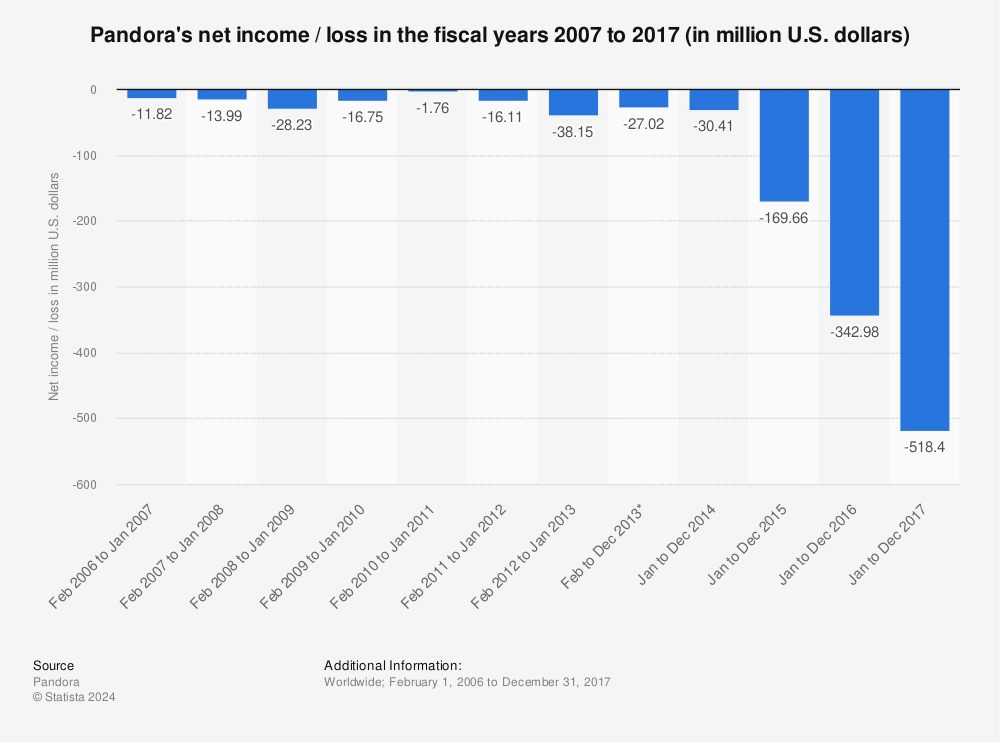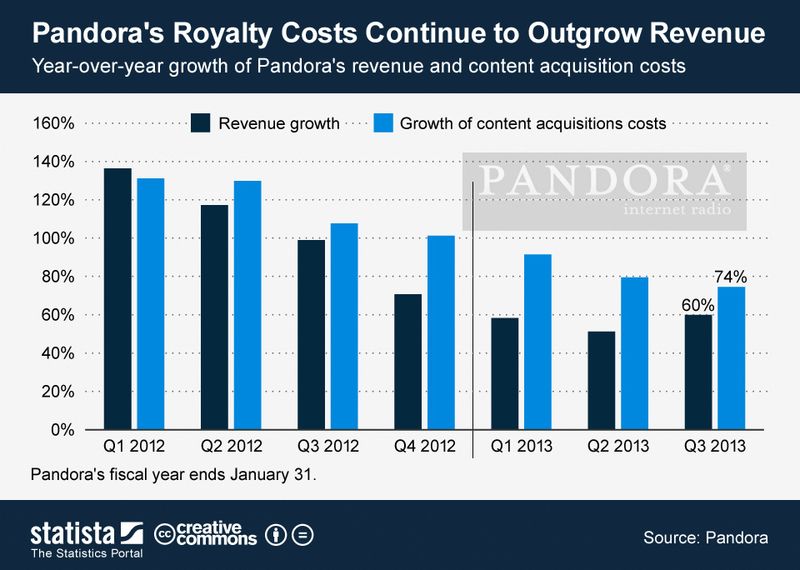One of the most fascinating things to observe as a huge music fan and somewhat "technology forward" individual is the shifting landscape of music consumption. The vast physical musical collections that used to line my shelves were eventually digitized and stored locally, until finally much of the music I consume comes from the cloud.
This topic has been the subject of tons of interesting chars and graphs, some of which I have cherry picked below from statista.com and buzzfeed.com. It seems clear that services like Spotify and Pandora (not to mention Mog, Rhapsody and others) need to actually be profitable to be sustainable and actually, you know, be the future of music. Let's have a look at the charts to see what they'll tell us about the music consumption today and tomorrow and transformation of the industry.
There are two main sources of revenue for music streaming companies like Pandora and Spotify: ads and subscription fees. Pandora primarily relies on ads, while Spotify has built a business giving "taste" for free, hoping that most users will pay for one of their two commercial offerings -- the so-called freemium model.
The first big question. Can the revenue that these companies bring in cover the costs of running the sites (minimal) and licensing of all that great music (huge)? The short answer, at least for now is "no".
Each company has methods for computing how rights holders are paid based on number of plays. You will often here of small fractions of cents paid per play -- and artists getting shafted. There is an element of truth to both of these tales. Most payments go to labels, who then decide how to compensate their artist rosters for streaming plays. The tiny payment per song is a necessity based on the amount of plays and revenue. The companies would quickly grow broke with at .99 per song. However, with a growing user base, these could eventually turn into not-insignificant revenue source (certainly more lucrative than the vast pirate market, which this is a clear and convenient alternative) for the most played artists. So how do you build a profitable business from this? Business 101 says to either grow revenue or shrink expenses. Marginal cost of bringing on new users is relatively low -- a positive sign.

But any attempt to change the formula of these services. Spotify is incredible because you can dial up virtually any song at any time -- it bests torrent sites and even iTunes for user experience. Fans turn to Pandora is because it serves relatively (compared to terrestrial radio) few ads and its algorithms play the songs they want to hear vs the tired formats selected in a board room. This means big payouts in expenses for these companies, and for the foreseeable future, more losses.


You will find more statistics at Statista
The potential market for both of these services is huge. Both casual and hardcore music lovers can benefit from services like this -- though their marketing strategies must advocate these types of services as the first place music lovers would go to hear a new tune. They will try to hook you into new social and "app platforms", making these service an integral part of listening, but also discovery, sharing and dialog surrounding music. A competing service, say youtube, fares much better in google searches and for any has become default since it took so long for services like these to emerge. Listener hours have steadily grown nonetheless.

... and Spotify's free and premium services both seem to be growing. Growth in paid actually outpaces free accounts considerably! Part of this is the viral and social nature of the platform itself. The subscription model ensures a stream of revenue month after month. Pandora, needs to refine its revenue models; be able to extract more targeted or local ads based on your music preference or customer profile. They also need to monetize the mobile platform.
But these services aren't here yet, and despite the growth, streaming isn't projected to make up the shortfall in downloads or physical sales. That said, the music industry must transform to keep pace with technology and perception of value in the market. Which brings me to the point I make time and time again in posts like these... The recording industry is a relic. The era of making a living from recorded music has come to a close. But there is still hope for musicians and even a chance for the truly creative, talented and hard-working to succeed enormously. Play live. Embrace innovation. Build an audience and repetoire. The past and the future of music is live.